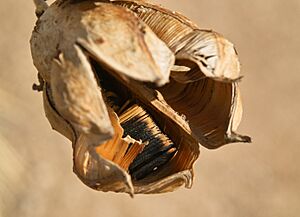Yucca elata facts for kids
Quick facts for kids Yucca elata |
|
|---|---|
 |
|
| Large soaptree yucca | |
| Scientific classification | |
 |
|
| Natural range | |
| Synonyms | |
|
The Yucca elata is a tall plant that lives for many years. People often call it the soaptree, soaptree yucca, soapweed, or palmella. This plant grows naturally in the southwestern parts of North America. You can find it in the Sonoran Desert and Chihuahuan Desert. It grows in the United States (western Texas, New Mexico, Arizona, southern Nevada, and southwestern Utah). It also grows in northern Mexico (Chihuahua, Coahuila, Sonora, and Nuevo León).
Contents
What the Soaptree Yucca Looks Like
This plant can grow quite tall, from about 1.2 to 4.5 meters (4 to 15 feet). It has a trunk that usually does not branch much. The trunk is brown and shaped like a cylinder. It is quite thin and sometimes has small holes. These holes are made by yucca moth larvae when they leave the plant.
The Yucca elata has long, thin leaves. They grow in a tight spiral at the top of the stems. Each leaf is about 25 to 95 centimeters (10 to 37 inches) long. They are very slender, only about 0.2 to 1.3 centimeters (0.1 to 0.5 inches) wide.
The plant produces white, bell-shaped flowers. These flowers grow in a thick bunch on a thin stem at the very top of the plant. Each flower is about 32 to 57 millimeters (1.3 to 2.2 inches) long. They are usually creamy white, but sometimes have a hint of pink or green.
The Yucca elata also grows a fruit called a capsule. This capsule is 4 to 8 centimeters (1.6 to 3.1 inches) long and 2 to 4 centimeters (0.8 to 1.6 inches) wide. It turns brown in the summer when it is ready. Then, it splits into three parts to let out its black seeds. These plants do not produce flowers every year.
Where the Soaptree Yucca Grows
These plants grow best in dry, desert-like areas. They can handle very cold weather. However, they need a lot of sunlight to grow well.
Different Kinds of Soaptree Yucca
Scientists sometimes recognize a few different types of Yucca elata. These are often called varieties or subspecies.
- Yucca elata ssp. elata: This type has large capsules, about 5 to 8 centimeters long. Its leaves are long, from 30 to 95 centimeters. You can find this type across the entire area where the plant grows.
- Yucca elata ssp. verdiensis: This type has smaller capsules, about 4 to 4.5 centimeters long. Its leaves are shorter, from 25 to 45 centimeters. This type is found only in Arizona.
How People Use Soaptree Yucca
Long ago, Native Americans used many parts of the soaptree yucca. They used the strong fibers from the leaves to make many useful things. These included sandals, belts, cloth, baskets, cords, and mats. They also ate the flowers from the plant.
Inside the trunk and roots of the plant, there is a substance that feels like soap. This substance is rich in natural chemicals called saponins. In the past, people often used this soapy substance as soap and shampoo. It was even used to help with dandruff and hairloss.
One tribe, the Zuni, used a special mix. They combined soap made from yucca sap with ground aster plants. They used this mix to wash newborn babies. They believed it helped the babies' hair grow. The Apaches also used yucca leaf fibers. They made them into dental floss and rope.
During times when there was not much rain, ranchers used the plant to feed their cattle. They would chop up the trunk and leaves, and the cattle could eat them.
The Soaptree Yucca as a Symbol
The flowers of the Yucca plant are the official state flowers of the US state of New Mexico. The law does not name a specific type of yucca. However, a book from 2012 about New Mexico's 100th anniversary mentions the soaptree yucca (Yucca elata). It says this is one of the most common types of yucca found in New Mexico.
See also
 In Spanish: Yucca elata para niños
In Spanish: Yucca elata para niños



